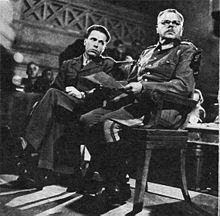Anton Dostler

Anton Dostler (born May 10, 1891 in Munich , † December 1, 1945 in Aversa , Province of Caserta , Italy ) was a German officer , most recently general of the infantry in World War II . Dostler had fifteen captured US Army soldiers executed during the Second World War . He was sentenced to death by a US court after the war and executed shortly afterwards .
Life
Bavarian Army
Dostler occurred on 23 June 1910 as a cadet in the 6th Infantry Regiment of the Bavarian army one in which he on 28 October 1912 Lieutenant was promoted. During the First World War on December 4, 1915, he received his first troop command in III. Army Corps , where he was promoted to first lieutenant on January 14, 1916 . His promotion to captain took place on October 18, 1918 and after the war, Dostler was accepted into the Reichswehr .
Reichswehr
On October 1, 1924, Dostler was transferred to the military intelligence department in the Reichswehr Ministry in Berlin . At the same time he began studying at the local university. He was promoted to major on April 1, 1932 .
Second World War
From August 24, 1939 to February 5, 1940, Dostler was chief of operations in the General Staff of the 7th Army and then Chief of Staff of the XXV. Army Corps , where he was promoted to major general on September 1, 1941 . Dostler was commanding the 57th Infantry Division from September 26, 1941 to April 9, 1942 and commanding general of the XXXXII on June 22, 1943 . Army Corps and temporarily the VII Army Corps. On January 1, 1943, he was promoted to lieutenant general . Anton Dostler took command of the LXXV on January 5, 1944. Army Corps in Italy.
On March 22, 1944, a command of fifteen US Army soldiers , including two officers , landed on the Italian coast, 100 kilometers north of the port city of La Spezia . Your task was to destroy a railway tunnel between La Spezia and Genoa . Two days later, they were captured by Italian and German soldiers. They were brought to La Spezia and imprisoned next to the headquarters of the 135th Fortress Brigade, which was under the command of the German Colonel Almers. The next higher headquarters , that of the LXXV. Army Corps, was commanded by Anton Dostler.
The captured American soldiers were interrogated and one of the officers revealed the mission's plan. This information was given to Dostler and the LXXV. Army corps delivered. He reported the case to the German Commander-in-Chief in Italy, Field Marshal Kesselring . This ordered the shooting of the Americans. An officer on Dostler's staff, Alexander zu Dohna-Schlobitten , should have forwarded the execution order, but refused. As he later wrote in his memoir, the uniformed soldiers had voluntarily gone into German captivity after their mission had failed and the German troops had been alerted. Dohna was certain of these facts because he had entered them in the war diary himself. In Dohna's opinion, this meant that the Americans were to be treated as prisoners of war - as a lower-ranking officer, however, in contrast to Dostler, he had no knowledge of Hitler's secret instruction, the so-called command order . Dohna was expelled from the army in May 1944 for disobedience and political unreliability because of his refusal. Dostler passed the execution order to the fortress brigade, which carried it out.
According to other sources, the Americans were initially mistaken for Italian partisans because they dressed accordingly (civil). They only revealed their true citizenship after the execution order had been announced .
Dostler became commander of the LXXIII on December 1, 1944. Army Corps.
After the end of the war

On May 8, 1945, he was captured by the Americans and charged in a US military tribunal in Caserta with the shooting of the 15-man American sabotage squad. Against the charge that he had issued an illegal order, Dostler relied on the so-called command order of October 18, 1942. This personal order from Hitler prescribed the immediate execution of allied commando soldiers captured, regardless of whether they were in uniform or not. Dostler saw himself only as a messenger of orders to Colonel Almers. The court did not follow his line of argument and sentenced him to death on October 12, 1945 . The verdict set a precedent for the Nuremberg Trials : the Allies did not accept the appeal to higher authority.
Anton Dostler was executed by firing squad on December 1, 1945 .
Awards
- Iron Cross (1914) 2nd and 1st class
- Bavarian Order of Military Merit IV class with swords
- Wehrmacht service award IV. To I. class
- Medal in memory of March 13, 1938
- Medal in memory of October 1, 1938 with Prague Castle clasp
- Clasp for the Iron Cross, 2nd and 1st class
- Medal Winter Battle in the East 1941/42
Web links
- The Dostler Case ( English )
- Dostler's defense ( English )
- Photo of Anton Dostler shortly before the execution on flickr.com
- Film documentation of Dostler's execution on YouTube
Individual evidence
- ^ Alexander Fürst Dohna-Schlobitten, Memories of an old East Prussia, p. 257, ISBN 3-8003-3115-2 .
- ^ Richard Raiber: Anatomy of perjury: Field Marshal Albert Kesselring, Via Rasella, and the Ginny Mission (p. 158)
- ↑ a b Ranking list of the German Imperial Army. Mittler & Sohn publishing house. Berlin. P. 134.
| personal data | |
|---|---|
| SURNAME | Dostler, Anton |
| BRIEF DESCRIPTION | German officer and general of the infantry in World War II |
| DATE OF BIRTH | May 10, 1891 |
| PLACE OF BIRTH | Munich |
| DATE OF DEATH | December 1, 1945 |
| Place of death | Aversa , Province of Caserta , Italy |